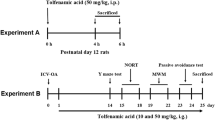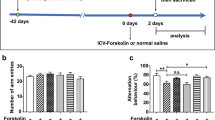Abstract
Hyperphosphorylation of Tau in Alzheimer’s disease (AD) brain appears to be caused by a down-regulation of protein phosphatase 2A (PP2A). In this study, we selectively inhibited PP2A by injection of okadaic acid (OA) into the Meynert nucleus basalis of rats and found that 0.4 pmol of OA injection induced approximately 60% inhibition of PP2A 24 h after injection, 13% inhibition 48 h after injection and no obvious inhibition 72 h after injection. Hyperphosphorylation of Tau at Ser-198/Ser-199/Ser-202 and Ser-396/Ser-404 and spatial memory deficit of, rats were induced 24 h after 0. 1 pmol of OA injection. This study suggests that a down-regulation of PP2A may underlie abnormal hyperphosphorylation of cytoskeletal proteins leading to neurofibrillary degeneration in AD.
Similar content being viewed by others
References
Arriagada P V, Growdon J H, Hedley-Whyte E T,et al. Neurofibrillary Tangles But Not Senile Plaques Parallel Duration And Severity of Alzheimer’s Disease,Neurology, 1992,42: 631–639.
Bancher C, Brunner C, Lassmann H,et al. Accumulation of Abnormally Phosphorylated Tau Precedes the Formation of Neurofibrillary Tangles in Alzheimer’s Disease.Brain Res, 1989,477:90–99.
Kopke E, Tung Y C, Shaikh Set al. Microtubule-Associated Protein Tau. Abnormal Phosphorylation of a Non-Paired Helical Filament Pool in Alzheimer Disease.J Biol Chem, 1993,268:24374–24384.
Alonso A C, Zaidi T, Novak M,et al. Hyperphosphorylation Induces Self-Assembly of τ into Tangles of Paired Helical Filaments/Straight Filaments.PNAS, 2001,98:6923–6928.
Gong C X, Singh T J, Grundke-Iqbal I,et al. Phosphoprotein Phosphatase Activities in Alzheimer Disease Brain.J Neurochem, 1993,61:921–927.
Gong C X, Shaikh S, Wang J Z,et al. Phosphatase Activity toward Abnormally Phosphorylated Tau: Decrease in Alzheimer Disease Brain.J Neurochem, 1995,65:732–738.
Wang J Z, Gong C X, Zaidi T,et al. Dephosphorylation of Alzheimer Paired Helical Filaments by Protein Phosphatase-2A and 2B.J Biol Chem, 1995,270: 4854–4860.
Goedert M, Jakes R, Qi Z,et al. Protein phosphatase 2A is the Major Enzyme in Brain That Dephosphorylates Tau Protein Phosphorylated by Proline-Directed Protein Kinases or Cyclic AMP-Dependent Protein Kinase.J Neurochem, 1995,65:2804–2807.
Gong C X, Lidsky T, Wegiel J,et al. Phosphorylation of Microtubule-Associated Protein Tau is Regulated by Protein Phosphatase 2A in Mammalian Brain Implications for Neurofibrillary Degeneration in Alzheimer’s Disease.J Biol Chem, 2000,275:5535–5544.
Tian Q, Wang J Z. Role of Serine/Threonine Protein Phosphatase in Alzheimer’s Disease.Neurosignals, 2002,11:262–269.
Sontag E, Nunbhakdi-Craig V, Lee G,et al.Regulation of the Phosphorylation State And Microtubule-Binding Activity of Tau by Protein Phosphatase 2A.Neuron, 1996,6:1201–1207.
Kim D, Su J, Cotman C W. Sequence of Neurodegeneration And Accumulation of Phosphorylated Tau in Cultured Neurons after Okadaic Acid Treatment.Brain Res, 1999,839: 253–262.
Sun L, Liu S Y, Wang J Z. Inhibition of PP2A and PP1 Induced Tau Hyperphosphorylation and Impairment of Spatial Memory Retention in Rats.Neurosci, 2003,118:1175–1182.
Whitehouse P J, Price D L, Struble R G,et al. Alzheimer’s Disease And Senile Dementia: Loss of Neurons in the Basal Forebrain.Science, 1982,215: 1237–1239.
Coyle J T, Price D L, DeLong M R. Alzheimer’s Disease: A Disorder of Cortical Cholinergic Innervation.Science. 1983,219:1184–1190.
Rasool C G, Svendsen C N, Selkoe D J. Neurofibrillary Dgeneration of Cholinergic and Noncholinergic Neurons of the Basal Forebrain in Alzheimer’s Disease.Ann Neurol, 198620:482–488.
Samuel W, Terry R D, De Teresa R,et al. Clinical Correlates of Cortical and Nucleus Basalis Pathology in Alzheimer Dementia.Arch Neurol, 1994,51:772–778.
Brandeis R, Brandys Y, Yehuda S. The Use of the Morris Water Maze in the Study of Memory and Learning.Int J Neurosci, 1989,48:29–69.
Paxinos C, Watson C J.The Rat Brain in Stereotasic Coordinates. 2nd Edition. New York: Academic Press, 1996.
Gong C X, Singh T J, Grundke-Iqbal I,et al. Alzheimer’s Disease Abnormally Phosphorylated Tau is Dephosphorylated by Protein Phosphatase-2B (Calcineurin).J Neurochem, 1994,62:803–806.
Bialojan C, Takai A. Inhibitory Effect of a Marine-Sponge Toxin, Okadaic Acid, on Protein Phosphatases Specificity and Kinetics.Biochem J, 1988,256:283–290.
Wang J Z, Tung T C, Wang Y,et al. Hyperphosphorylation and Accumulation of Neurofilament Proteins in Alzheimer Disease Brain and in Okadaic Acid-Treated SY5Y Cells.FEBS Lett, 2001,507:81–87.
Gong C X, Wang J Z, Iqbal K,et al. Inhibition of Protein Phosphatase 2A Induces Phosphorylation and Accumulation of Neurofilaments in Metabolically Active Rat Brain Slices.Neurosci Lett, 2003,340:107–110.
Lee J, Hong H, Im J,et al. The Formation of PHF-1 and SMI-31 Positive Dystrophic Neurites in Rat Hippocampus Following Acute Injection of Okadaic Acid.Neurosci Lett, 2000282:49–52.
Vogelsberg-Ragaglia V, Schuck T, Trojanowski J Q,et al. PP2A mRNA Expression is Quantitatively Decreased in Alzheimer’s Discase Hippocampus.Exp Neuron, 2001,168: 402–412.
Author information
Authors and Affiliations
Corresponding author
Additional information
Foundation item: Supported by the National Natural Science Foundation of China (30370560, 39925012, 30100057, 30170221) and a Grant from the Li Foundation, USA
Biography: TIAN Qing (1973-), female, M. D., research direction: neuropathophysiology.
Rights and permissions
About this article
Cite this article
Qing, T., Hong-yun, Z., Juan, C. et al. Spatial memory deficit and Tau hyperphosphorylation induced by inhibiting PP2A in rat brain. Wuhan Univ. J. Nat. Sci. 10, 1030–1034 (2005). https://doi.org/10.1007/BF02832462
Received:
Issue Date:
DOI: https://doi.org/10.1007/BF02832462




